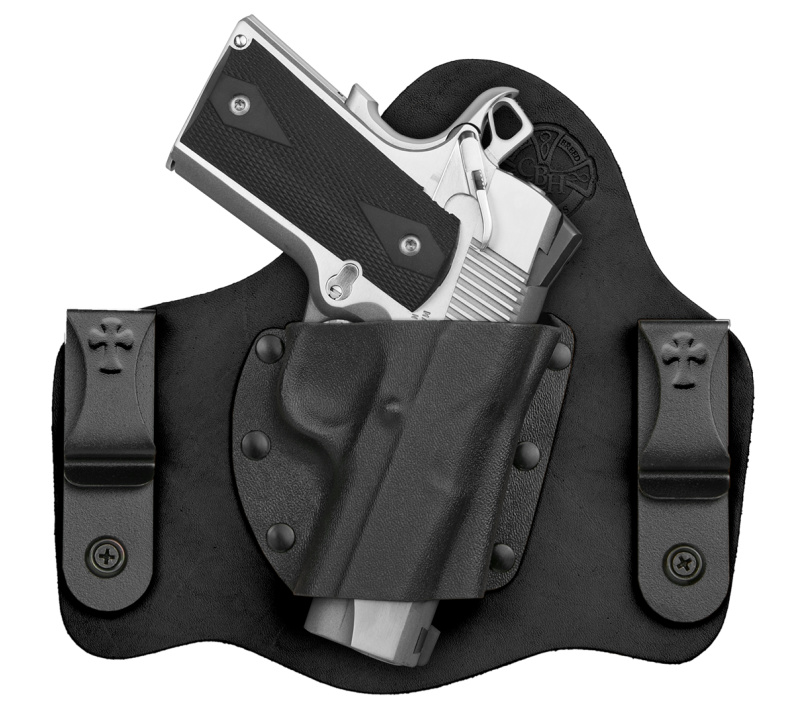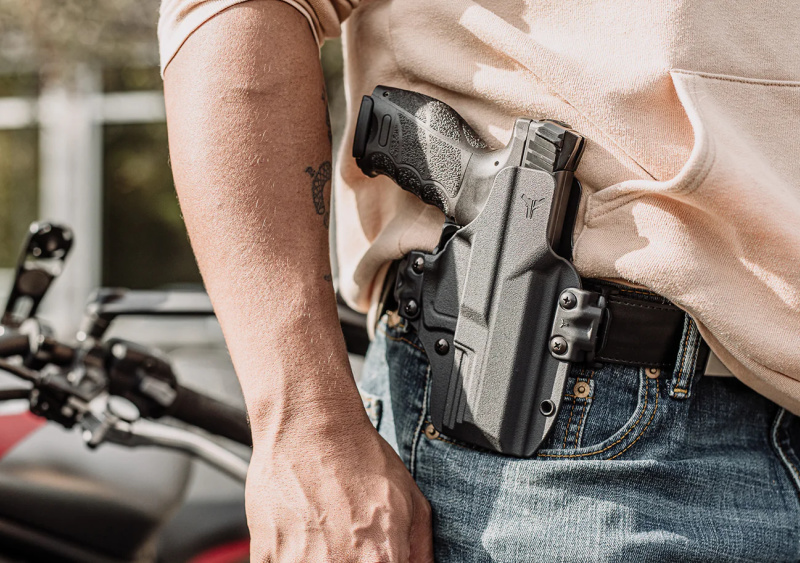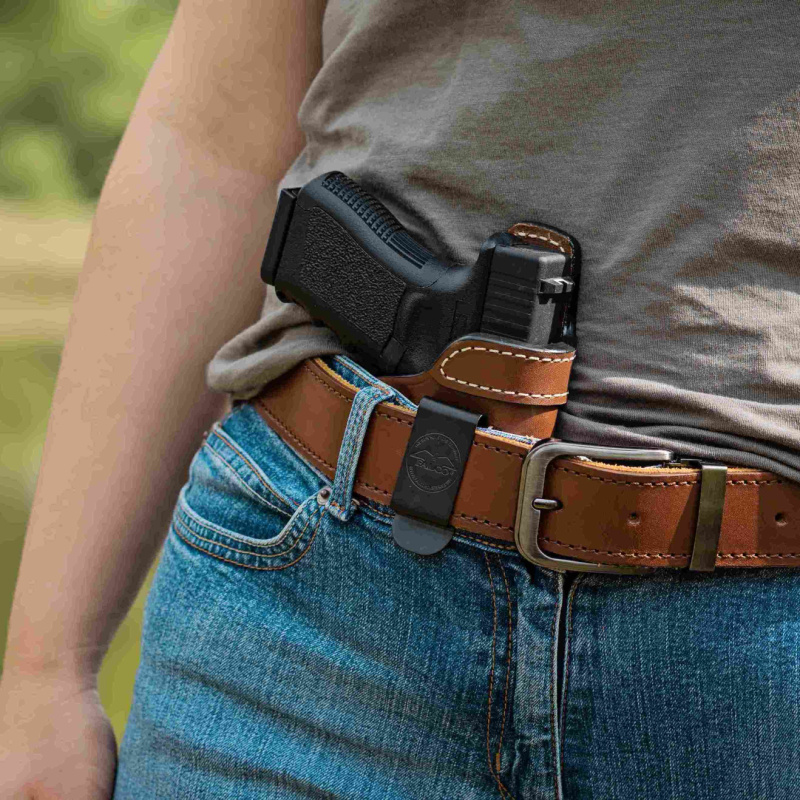“I can’t carry my gun. It’s uncomfortable and impossible to conceal.” Comments like this are rather common, but in reality, these issues are typically not only diagnosable but fixable with a proper holster (and gun belt, but today we’re focusing on holsters). There are some things you can do to streamline the holster selection process, and we’re here to help. Check out these tips and tricks for how to choose a holster, with a few extra carry tips along the way.

What kind of holster should you get?
When it comes to what kind of holster you should get there are a few answers, depending on what aspect of holsters you’re talking about. Things to consider include the material the holster is made from, whether the holster is made for open carry or concealed carry, and where on your body you intend to carry it. First, let’s talk about material choices. These include:
- Leather
- Kydex (or a similar molded plastic material)
- Nylon
- Hybrid (leather back, Kydex face)
The material your holster is made from needs to be capable of withstanding serious use and should assist in retention, meaning it needs to be molded to the shape of your gun. That means nylon is never the answer because holsters made from nylon are typically nothing more than loose sleeves. Leather can be fantastic when it’s made and reinforced correctly. Hybrid designs have pitfalls but can be good if you know what signs of wear to watch for. Kydex tends to be king because it provides the greatest level of retention and wear resistance, but not all plastic blend holsters are made equally, and they have downsides, too. There’s simply no such thing as a holster that’s perfect for each and every situation, so you need to fine-tune it according to your needs and its specific use.
Regarding open carry versus concealed carry, it’s accurate to state that concealed carry is preferable. Although there are situations where open carry is sensible, such as while hunting or out on your own property, concealed carry is typically the go-to. That brings us to the next point, which is where on your body you intend to carry.
Immediately behind your strong side hip and AIWB (appendix inside the waistband) are perhaps the two most common ways to carry a handgun. Other methods such as small of back and cross draw aren’t as common or as easy or efficient. If you want to consider a broad spectrum of on-body carry methods for handguns, they include:
- Strong side hip
- Off-side hip for a cross draw
- AIWB (appendix inside waistband)
- Small of back
- Shoulder holster
- Ankle holster
- Belly band

What makes a holster good?
When we’re talking about a good holster, we mean one with some specific features and capabilities, including:
- Retention (whatever level you require, but it does need to have at least basic retention, as opposed to being loose and unable to hold onto the gun at all).
- A reinforced, rigid mouth that remains open for holstering the gun, meaning it does not collapse or otherwise close, requiring you to use your hand or an object to open the holster for use.
- A back piece that also does not collapse, in the case of hybrid designs.
- Adjustable retention, as necessary or required.
- Adjustable for ride height and cant to fit your specific needs.
- Rigid but not brittle, for Kydex and other plastic blend holsters.
- Designed for carry on the specific part of your belt line you want to carry (it matters).
- Reinforced stitching on leather holsters.
- Molded to the exact model of gun for Kydex/plastic holsters
- Made to work with your dominant hand. If you’re left-handed, get a left-handed holster, don’t simply try to make a right-handed design work.
- Protects and covers the trigger.
- Optics compatible if you intend to use a red dot sight (do not plan to simply cut a gap in the holster yourself).

How do you choose a holster?
Once you’ve narrowed down where on your body you intend to carry and what you’d like the holster to be made from, you can start your holster journey. It’s definitely a journey because it’s never simple to find the ideal holster for your purpose. There’s a reason most gun owners have boxes and closets full of discarded holsters: it’s not because we’re incapable of deciding, it’s because the fit is so personal and it takes time to find the correct design. When you do find the right holster, get more than one.
For concealed carry, you’re going to want a holster that sits close to your body. This both creates a more comfortable carry situation and reduces risks of snags and printing. If possible, get a holster that can be adjusted for ride height and cant so the height at which the gun sits and the angle can be changed. That isn’t always possible, but it’s a nice option to have.
Your holster should remain on your belt in the same spot without slipping or leaning, and it should firmly retain the handgun. That means there shouldn’t be any sloppiness or shifting of the handgun within the holster. Using a correct width belt to go with the loop size of the holster will help hold it in place on your belt, but that also requires the use of quality materials and a solid design. And, of course, if the belt you put the holster on is too flimsy to handle holding up a loaded handgun, the holster is going to be dragged down regardless of its quality. Always pair a good belt with your holster.

How do you know it’s a good holster?
The holster should fulfill the requirements listed above such as providing good retention, covering the trigger, and having a mouth that remains rigid and open for holstering. Assuming the holster you choose does its job in general, it’s time to consider whether it’s good for you, specifically. Does your holster:
- Hold the handgun at the correct height and spot on your belt from a smooth draw stroke?
- Keep the gun upright and close to your body rather than allowing the grip to lean outward?
- Fit the shape of your body without poking you or otherwise making carry uncomfortable?
- Properly conceal the handgun? (Keeping in mind that holster needs can vary depending on your clothing.)
- Remain comfortable and in place even as you move around, including while sitting?
If your holster doesn’t seem to be working out, first ask yourself if the real issue is the belt. If the belt is sturdy and doing its part but the holster still doesn’t work well, it’s time to try another one. It’s important to remember that carrying a gun does take some getting used to and adjusting, so don’t rush to toss a holster (and don’t actually toss it out, just set it aside).
Take your time and be prepared to go through quite a few holsters before you find one that works well for you. When you find a good holster, it’ll all have been worth it.


